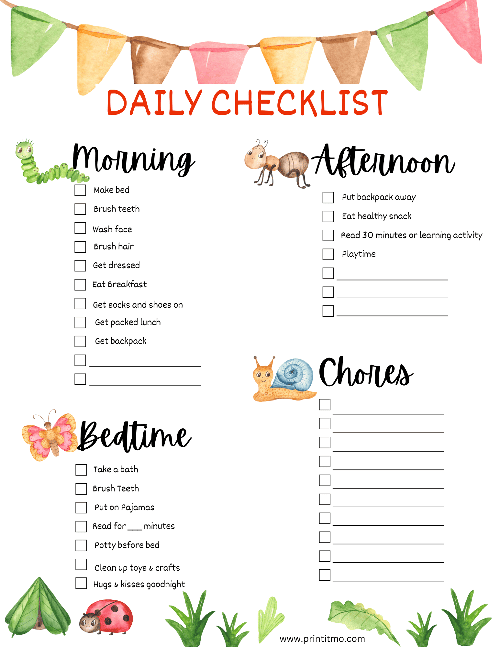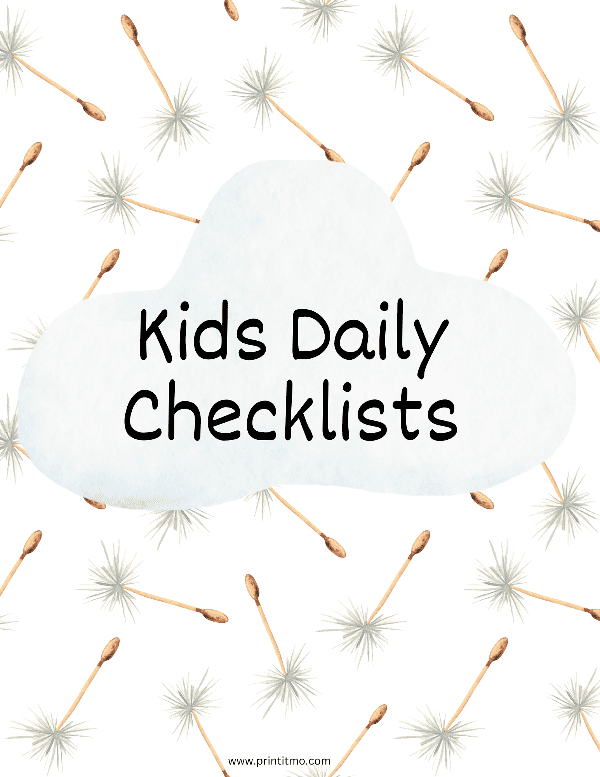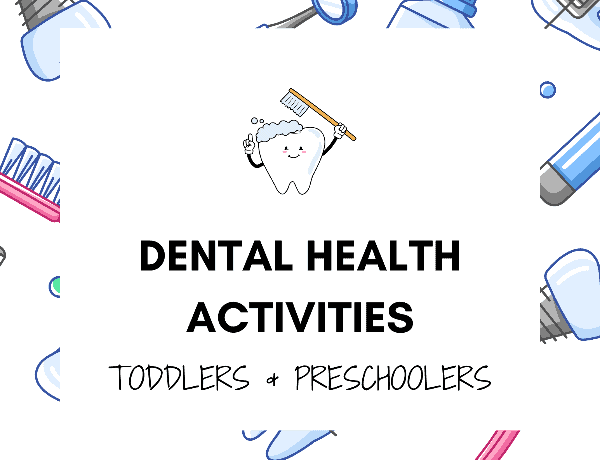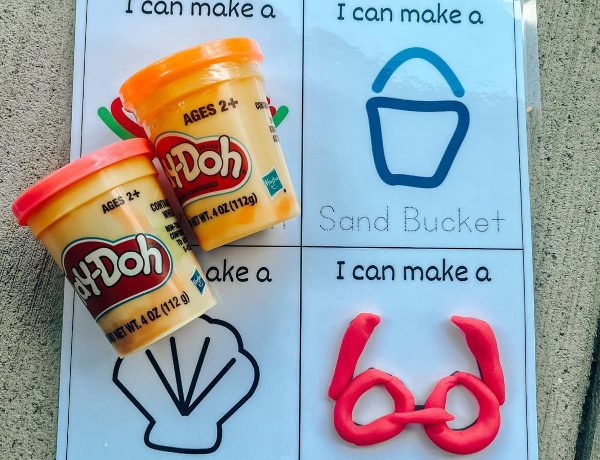Are your kids constantly forgetting to brush their teeth, feed the dog, or pick up their toys before bed? We all know that feeling as parents being pulled in a million directions helping with multiple activities and responsibilities. But at some point we have to let our kids do their fair share. As much, or as little as their age allows.
My solution for you – a kids’ daily checklist that they can check-off as they go so they won’t forget a thing. This simple tool can serve as a powerful aid in helping them manage their tasks quickly while fostering independence. Whether you have 1 kid or 5 doing all the things can become a bit chaotic. So let’s foster a little independence and get organized in this madhouse we call parenting. Grab a pen and get ready to help them start checking off their daily to do list.
I broke my printable daily checklist for kids down into 4 sections with the most common tasks kids do from day to day listed. The chore section is open space for you to add in chores assigned to your kids. Included in this printable checklist are 2 different style to do list.
I highly recommend printing each checklist on cardstock paper and laminating each sheet for longevity.

Related: Printable Emotions Worksheets For Kids
Daily Checklist For kids Ideas
How we begin our day can often set the tone for the rest of it.
Morning Routine Task:
| Brush teeth and wash face |
| Get dressed in clothing for the day |
| Make bed |
| Eat a healthy breakfast |
| Pack a school bag with necessary books, assignments, and supplies |
| Double-check homework and ensure it is completed |
| Organize school lunch or money for lunch |
| Put on shoes and socks |
| Comb or brush hair |
| Gather any after-school activity items (sports gear, musical instrument, etc.) |
| Say goodbye to family and leave home on time for school or bus stop |
| Practice good manners while interacting with others throughout the morning routine |
School-related tasks:
| Completing homework assignments |
| Reviewing and studying for upcoming tests or quizzes |
| Packing necessary books, notebooks, and supplies for the day |
| Organizing and cleaning out backpacks regularly |
| Keeping track of important dates such as project deadlines or field trips |
| Maintaining a neat and organized study space at home |
Afternoon tasks:
| Homework completion: Ensure all homework assignments are completed before moving on to other tasks. |
| Tidy up room: Teach kids the importance of cleanliness and organization by including tidying up their room in the checklist. |
| Snack time: Pick a snack time in the afternoon routine. |
| Physical activity: Dedicate time for kids to engage in physical activities like playing outside, riding bikes, or taking part in sports. |
| Chores: Assign age-appropriate chores such as setting the table, cleaning up after meals, or taking out the trash. |
| Reading time: Set aside a dedicated period for reading books or engaging in educational activities that promote learning and imagination. |
| Creative play: drawing, coloring, painting, or any other art |
Chores or responsibilities at home:
| Making the bed every morning |
| Putting dirty clothes in the laundry hamper |
| Cleaning up toys and games after playing |
| Setting the table for meals |
| Clearing the table after meals |
| Feeding pets and cleaning their living areas |
Related: Fun Kids Role Play Ideas
How To Implement A Daily Checklist For Kids
1. Assess age-appropriate tasks: Consider your child’s age, abilities, and responsibilities. Break down their routine into manageable tasks for their level of maturity. For younger kids, it might include simple activities like making the bed or brushing teeth, whereas older children can handle more complex chores such as doing laundry or completing homework assignments.
2. Prioritize important activities: Identify the most critical tasks that must be completed each day, such as finishing homework, reading, or practicing musical instruments. Make sure these essentials are at the top of the list.
3. Visual checklist: Keep it simple and easy-to-understand. Using the checklist, tick off completed tasks throughout the day.
4. Set realistic goals: Ensure that expectations are reasonable based on your child’s capabilities and schedule.
5. Establish consistent routines: Encourage consistency by establishing times everyone can stick to for specific activities within your child’s routine.
6. Offer incentives/rewards system: Consider introducing a reward system linked with the completion of daily tasks from the checklist—stickers upon completing all assignments within scheduled time limits or earning points towards small rewards like extra screen time or a favorite activity.
7. Encourage self-management: Gradually transition from constant supervision to more independence.
If you are looking for a more interactive kids routine chart, check out my Interactive Chore Chart for kids.

Related: Imagination Play Ideas For Toddlers
Tips For Successful Implementation Of Kids Daily Routine Chart
- Involve your child in the process
- Keep it simple
- Create consistency
- Be flexible
- Set realistic expectations be on their ability
- Celebrate achievements
- Regularly review and adjust
Related: Printable Drawer Labels For Kids Clothes
Do Kids Need Routine?
1. The Importance of Teaching Kids Responsibility: Responsibility is an essential skill that allows children to become self-reliant individuals. A daily checklist acts as a visual reminder of tasks they need to complete regularly, teaching them accountability and time management skills.
2. Structuring the Daily Checklist: Creating an organized daily checklist tailored specifically for your child’s routine encourages them to follow a consistent schedule. Include activities such as brushing teeth, making the bed, homework assignments, reading time, or any other chores appropriate for their age group.
3. Encouraging Independence: Kids are so proud when they’ve conquered a goal assigned to them all on their own. That self satisfaction motivates them further.
4. Breaking Down Tasks into Manageable Chunks: If you can divide larger responsibilities into smaller steps within the daily schedule for kids they can easily comprehend and accomplish each one.
5. Developing Time Management Skills: You can include estimated time frames alongside each task to help your kids develop an understanding of how long certain activities should take.
6. Tracking Progress and Celebrating Achievements: Checkboxes on the daily checklist allows kids to track their progress throughout the day visually. Once all tasks are completed, celebrate their achievements together.
7. Adapting the Checklist: As children grow older, their daily routines evolve, and so should their checklists. Adjust their daily checklist from time to time to align with their changing responsibilities. This will help with continued effectiveness in promoting organization and productivity.
Related: Creative Summer Worksheets For Preschoolers
Using a daily checklist for kids can have lots of benefits in their overall development and sense of responsibility. By teaching them how to prioritize tasks, organize their time, and complete activities independently, they become more self-reliant and better equipped to handle daily challenges of everyday life.
Also, a daily checklist instills discipline and fosters a sense of accomplishment when tasks are completed. Ultimately, this simple tool helps kids stay on track with their responsibilities.




No Comments